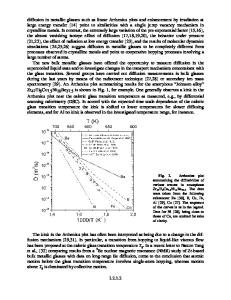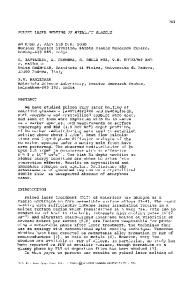Fluctuation of Internal Friction in Metallic Glasses
- PDF / 626,233 Bytes
- 5 Pages / 595.22 x 842 pts (A4) Page_size
- 116 Downloads / 462 Views
FLUCTUATION OF INTERNAL FRICTION IN METALLIC GLASSES Y. Miyauchi1, R.Tamura1, Y. Hiki2 1 Department of Materials Science and Technology, Science University of Tokyo Noda , Chiba 278-8510, Japan 2 Department of Physics, Tokyo Institute of Technology, Emeritus 39-3-303 Motoyoyogi, Shibuya-ku, Tokyo 151-0062, Japan Abstract Internal friction (IF) of a metallic glass Zr55Cu30Al10Ni5 has been measured near the glass transition temperature Tg (= 666 K). The measurement is performed by using DMA (TA Instrument) apparatus at a frequency of 0.01 Hz for a specimen stabilized by annealing. The specimen is kept at a constant temperature T, and the IF value Q-1 is measured as a function of time t. A fluctuation of Q-1 with time is seen, and the magnitude of the fluctuation, F(t), is derived from the Q-1-vs-t data. F(t) is Fourier transformed to the frequency spectrum F(f). Such experiment and analyses are carried out at various temperatures near Tg. A characteristic peak (f ~ 10-3 Hz) is found in the spectrum F(f) in the glass transition region. Introduction In a glass-forming process, a material in the liquid state is cooled to the supercooled state instead of the crystalline state, and to the glassy state at the glass transition temperature Tg. The supercooled state is a quasi-stable liquid state, and the glassy state is a frozen-in liquid and is not a stable state. The energies of both states are higher than that of the crystal, and the states are apt to change to more stable one. The composing atoms can rather easily move and relaxations due to their motions occur. We can obtain useful knowledge on the glass-forming materials by observing the relaxation phenomena. We are interested in mechanical relaxations in glassy materials, especially near Tg. The motivation is to obtain understanding of the characteristics of the glassy state and the glass transition phenomenon. Measurement of internal friction (IF) or mechanical damping is useful for studying the mechanical relaxation. Meanwhile, the metallic glasses are important materials in science and engineering. We have successively studied the internal friction of metallic glasses [1-10]. Now, it is considered from the statistical mechanics that a relaxation of a physical property is accompanied by its fluctuation. Thus, the fluctuation of IF in a metallic glass is intended to be studied especially near Tg, which may provide another aspect of dynamics of glasses.
1
Experimental methods The measurement of IF is carried out using an apparatus Dynamical Mechanical Analyzer (DMA type Q800, TA Instrument, Newcastle, DE, USA). IF can be measured in the temperature range –150 ~ 600oC at the frequency 0.01 ~ 200 Hz and at the specimen displacement amplitude 0.5 ~ 10000μm. The deformation mode of the specimen adopted is the cantilever bending. At a definite temperature with a definite strain amplitude and frequencies IF can quickly be measured from the phase difference between stress and strain. The method of preparing Zr55Cu30Al10Ni5 specimens used is as follows. A mother alloy ingot
Data Loading...











